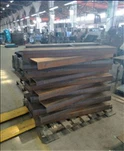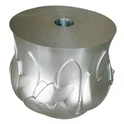Hey there! As a supplier in the metal welding biz, I often get asked about the welding speed for TIG (Tungsten Inert Gas) welding. It's a crucial factor that can make or break a welding project, so let's dive right in and explore what it's all about.
What's TIG Welding?
Before we talk about the welding speed, let's quickly go over what TIG welding is. TIG welding is a process where an electric arc is created between a non - consumable tungsten electrode and the workpiece. An inert gas, usually argon, is used to shield the weld area from atmospheric contamination. This results in high - quality, clean welds, which is why it's popular in industries like aerospace, automotive, and custom metal fabrication.
Why Does Welding Speed Matter?
The welding speed in TIG welding has a direct impact on the quality and efficiency of the weld. If the speed is too slow, you might end up with excessive heat input. This can cause the metal to warp, distort, or even melt through. On the other hand, if the speed is too fast, the weld might not penetrate properly, leading to weak joints and poor overall quality.


Factors Affecting TIG Welding Speed
Material Thickness
One of the biggest factors is the thickness of the material you're welding. Thicker materials generally require a slower welding speed. For example, when welding a thin sheet of aluminum (say, around 1/16 inch thick), you can get away with a relatively fast welding speed. But if you're working on a 1/2 - inch thick steel plate, you'll need to slow down to ensure proper penetration. As a rule of thumb, for every increase in material thickness, you should decrease the welding speed proportionally.
Material Type
Different materials have different melting points and thermal conductivities, which affect the welding speed. Metals like aluminum have high thermal conductivity, meaning they dissipate heat quickly. So, you might need to increase the welding speed to keep up with the heat loss. Steel, on the other hand, has a lower thermal conductivity, and you can usually weld it at a slower pace. For instance, when welding stainless steel, a slower speed can help achieve a more aesthetically pleasing and high - quality weld.
Joint Design
The type of joint you're creating also plays a role. A butt joint might require a different welding speed compared to a lap joint or a corner joint. In a butt joint, you need to ensure full penetration, so the speed might be slower. In a lap joint, the welding speed can sometimes be a bit faster as there's more material overlap.
Typical TIG Welding Speeds
It's hard to give an exact number for TIG welding speed because it varies so much based on the factors mentioned above. However, I can give you some ballpark figures.
For thin aluminum sheets (less than 1/8 inch), you might be able to weld at speeds ranging from 8 to 12 inches per minute. When welding steel of similar thickness, the speed could be around 6 to 10 inches per minute. For thicker materials, say 1/4 - inch thick aluminum, the speed might drop to 4 to 6 inches per minute, and for 1/4 - inch thick steel, it could be around 3 to 5 inches per minute.
Finding the Right Welding Speed
The best way to find the right welding speed for your project is through testing. Start with a sample piece of the same material and thickness as your actual workpiece. Try different welding speeds and observe the results. Look at the bead appearance, penetration, and overall quality of the weld. You can also use techniques like measuring the heat - affected zone to get a better understanding of how the speed is affecting the weld.
If you're new to TIG welding, it might take a bit of practice to get the hang of it. But with time, you'll be able to quickly determine the optimal speed for different jobs.
Our Services as a Metal Welding Supplier
At our Metal Welding supply, we understand the importance of getting the welding speed right. We offer a wide range of services to help you with your metal welding needs. Whether you're looking for High Quality Structural Steel Fabricators Stamping Bending Welding Fabrication, Customized Carbon Steel Welding and Fabrication with Powder Coating and Assembly Processing, or Custom Sheet Metal Aluminum Frame Aluminium Welding, we've got you covered.
Our team of experienced welders is well - versed in TIG welding and can ensure that the welding speed is just right for your project. We use the latest equipment and techniques to provide high - quality welds that meet your specifications.
Contact Us for Your Welding Needs
If you're in the market for metal welding services, don't hesitate to reach out. We're here to answer any questions you might have about TIG welding speed or any other aspect of our services. Whether you're a small business looking for custom metal parts or a large corporation in need of mass production, we can work with you to find the best solutions.
References
- Welding Handbook, American Welding Society
- TIG Welding Techniques, Practical Welding Today Magazine






